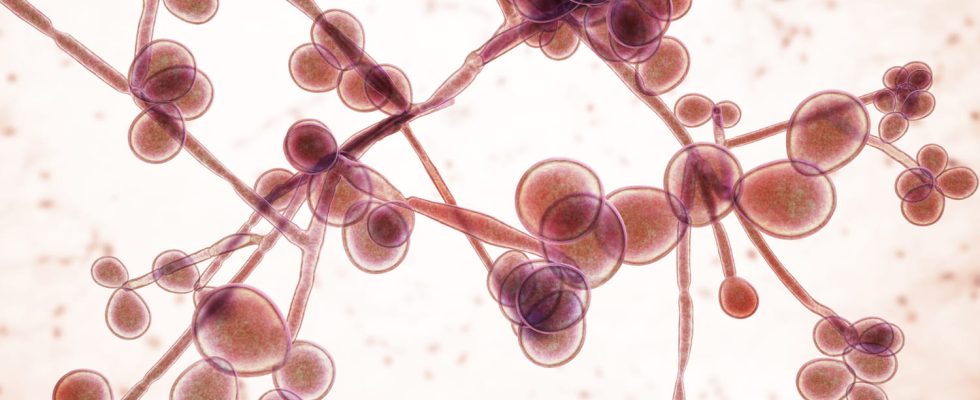Candida albicans is a microscopic fungus, usually harmless and present in the genital tract, digestive tract, mouth and on the skin. It can sometimes become pathogenic.
Candida albicans is a mycotic organism, i.e. it belongs to the family of mushrooms. It has always been present on our mucous membranes, our skin, or even in our intestine. During an immune or hormonal imbalance, it proliferates and becomes pathogenic by releasing toxins. For women or menit can be responsible for a candidiasis which causes mycoses, usually benign but which can be serious in a fragile person.
Is candida albicans dangerous?
When candida albicans affects weakened organisms, that is to say whose immune defenses are reduced, as in people carrying the AIDS virus or patients undergoing immunosuppressive treatment (in the context of autoimmune diseases, treatments for cancers or after a transplant), candidiasis develops and can be difficult to treat. Generally, the lesions caused by candida albicans on the mucous membranes or the skin are not serious. But they can be more serious when they reach the digestive viscera or the lungs. In extreme cases, candida albicans septicemia is possible and has a severe prognosis, but this remains exceptional. Candida albicans infection can also be following treatment with antibioticswhich has the effect of unbalancing the natural flora.
What causes the risk of infection?
Here is what increases the risk of candidiasis:
- The stress
- Excess sugar
- Taking certain medications, such as birth control pills or antibiotics
- The pregnancy
- Diabetes
What are the symptoms of a Candida albicans infection?
Candida albicans manifests itself differently depending on its location. It generally leads to fatigue of the body, physical but also psychological fatigue with a lack of desire, bloating, end-of-day headaches with the impression of having your head locked in a vice, a constant desire to eat sugar.
In immunocompetent patients, that is to say whose defense system is effective, it leads to:
- A Lily of the valley in the mouth (common in infants),
- redness and itching on the skin, mainly in the folds (hot and humid areas favorable to the development of yeasts),
- anal itching,
- small local genital inflammations such as urethritis in men or vulvovaginitis with whitish discharge and itching in women.
In immunocompromised patients:
- the fungus mainly develops in the mouth and esophagus and causes swallowing disorders. It’s a digestive mycosis.
In athletes especially:
- candida albicans frequently develops in the feet, due to chronic humidity caused by sweating.
This infection is mild but causes significant discomfort and tends to recur.
The diagnosis of the presence of candida albicans is above all clinical, with, for example, the classic oral thrush, producing a whitish deposit on the tongue and mucous membranes. In case of resistance to well-conducted treatment, a sample can be taken from the mucous membranes to confirm the presence of the fungus. Complementary examinations are useful in the case of sepsis, in particular with blood cultures which make it possible to identify the germ in question.
A skin or mucosal infection due to candida albicans requires topical antifungals in powder or ointment form in order to stop the proliferation of this yeast. The treatment of fungal infections can last several weeks and it is necessary to go to the end to limit the risk of recurrence. This treatment, which is generally effective, does not exclude recurrence. Sometimes an oral antifungal is needed.
“It is necessary to perfectly dry off after shower because humidity is a favorable environment for the development of mycoses” warns Dr. Della Valle. Good food hygiene can limit the proliferation of candida albicans in the body. Prevention also involves perfect body hygiene. However, it is difficult to anticipate the pathogenesis of candida albicans in immunocompromised patients, especially HIV patients at an advanced stage.
